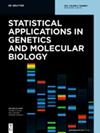Belief propagation in genotype-phenotype networks
IF 0.9
4区 数学
Q3 Mathematics
Statistical Applications in Genetics and Molecular Biology
Pub Date : 2016-03-01
DOI:10.1515/sagmb-2015-0058
引用次数: 7
Abstract
Abstract Graphical models have proven to be a valuable tool for connecting genotypes and phenotypes. Structural learning of phenotype-genotype networks has received considerable attention in the post-genome era. In recent years, a dozen different methods have emerged for network inference, which leverage natural variation that arises in certain genetic populations. The structure of the network itself can be used to form hypotheses based on the inferred direct and indirect network relationships, but represents a premature endpoint to the graphical analyses. In this work, we extend this endpoint. We examine the unexplored problem of perturbing a given network structure, and quantifying the system-wide effects on the network in a node-wise manner. The perturbation is achieved through the setting of values of phenotype node(s), which may reflect an inhibition or activation, and propagating this information through the entire network. We leverage belief propagation methods in Conditional Gaussian Bayesian Networks (CG-BNs), in order to absorb and propagate phenotypic evidence through the network. We show that the modeling assumptions adopted for genotype-phenotype networks represent an important sub-class of CG-BNs, which possess properties that ensure exact inference in the propagation scheme. The system-wide effects of the perturbation are quantified in a node-wise manner through the comparison of perturbed and unperturbed marginal distributions using a symmetric Kullback-Leibler divergence. Applications to kidney and skin cancer expression quantitative trait loci (eQTL) data from different mus musculus populations are presented. System-wide effects in the network were predicted and visualized across a spectrum of evidence. Sub-pathways and regions of the network responded in concert, suggesting co-regulation and coordination throughout the network in response to phenotypic changes. We demonstrate how these predicted system-wide effects can be examined in connection with estimated class probabilities for covariates of interest, e.g. cancer status. Despite the uncertainty in the network structure, we demonstrate the system-wide predictions are stable across an ensemble of highly likely networks. A software package, geneNetBP, which implements our approach, was developed in the R programming language.基因型-表现型网络中的信念传播
图形模型已被证明是连接基因型和表型的有价值的工具。表型-基因型网络的结构学习在后基因组时代受到了相当大的关注。近年来,出现了十几种不同的网络推断方法,这些方法利用了某些遗传群体中出现的自然变异。网络本身的结构可以用来根据推断的直接和间接网络关系形成假设,但对于图形分析来说,这是一个过早的终点。在这项工作中,我们扩展了这个端点。我们研究了干扰给定网络结构的未探索问题,并以节点明智的方式量化了对网络的系统范围影响。通过设置表型节点值来实现扰动,表型节点值可能反映抑制或激活,并通过整个网络传播该信息。我们利用条件高斯贝叶斯网络(cg - bn)中的信念传播方法,以便通过网络吸收和传播表型证据。我们表明,基因型-表型网络采用的建模假设代表了cg - bn的一个重要子类,它具有确保在传播方案中精确推断的特性。通过使用对称kullbackleibler散度比较扰动和未扰动的边际分布,以节点方式量化了扰动的系统范围效应。本文介绍了不同小家鼠群体中肾癌和皮肤癌表达数量性状位点(eQTL)数据的应用。通过一系列证据预测和可视化网络中的全系统效应。网络的子通路和区域一致响应,表明整个网络在响应表型变化时共同调节和协调。我们展示了如何将这些预测的全系统效应与相关协变量(如癌症状态)的估计类概率联系起来进行检验。尽管网络结构存在不确定性,但我们证明了系统范围的预测在高度可能的网络集合中是稳定的。用R编程语言开发了一个软件包geneNetBP,它实现了我们的方法。
本文章由计算机程序翻译,如有差异,请以英文原文为准。
求助全文
约1分钟内获得全文
求助全文
来源期刊
CiteScore
1.20
自引率
11.10%
发文量
8
审稿时长
6-12 weeks
期刊介绍:
Statistical Applications in Genetics and Molecular Biology seeks to publish significant research on the application of statistical ideas to problems arising from computational biology. The focus of the papers should be on the relevant statistical issues but should contain a succinct description of the relevant biological problem being considered. The range of topics is wide and will include topics such as linkage mapping, association studies, gene finding and sequence alignment, protein structure prediction, design and analysis of microarray data, molecular evolution and phylogenetic trees, DNA topology, and data base search strategies. Both original research and review articles will be warmly received.

 求助内容:
求助内容: 应助结果提醒方式:
应助结果提醒方式:


